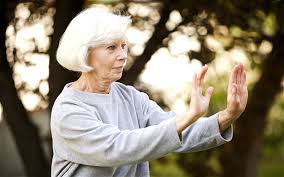Osteopenia Coordination exercises
Osteopenia Coordination exercises can save you the inconvenience of falling and experiencing a fracture. As we age, our balance deteriorates but so does our co-ordination. Poor co-ordination can make for momentary confusion. Our arms and legs do not act as they should and we can trip, slip or miss our step. So most of us can benefit from a co-ordination practice for a few minutes a day.
Now if you still play soccer or tennis or if you are an ardent ping pong player you may be getting lots of practice. But why not take this short Co-ordination test to see how you do?
Osteopenia Coordination exercises test preliminaries.
This is a simple test. You can do it in the kitchen or any place where there is a counter or railing that comes just above your waist. But you should only take this test if you have 'passed' the Osteopenia Balance tests. Why?
If your balance is not good, you could fall during this Osteopenia Coordination test. That would not be good - especially since you know your bones are not as strong as you would like. You do not want to suffer a fracture by falling during this test. So please, be sure you have your balance up to speed before you try this test. (It also makes a lot of sense to have someone else present when you do this test - AND to make sure you dog or cat is not around. They could get excited, run over and trip you up.) OK? Ready.
Directions for the Osteopenia exercises coordination test:
- Toe Walking. Go to the far end of the kitchen counter. Now walk to the other end of the counter on your toes. If you need to touch the counter for balance or come down off your toes, stop. How far did you get before having to stop?
- Heel Walking. Now do the same thing only this time walk on your heels so your toes do not touch the floor.
- Cross-over walking. Stand facing the counter. Be sure you are about one foot away from the edge so you can move your feet easily and still grab the counter if you need it to keep your balance. Now walk sideways, crossing your right leg in front of your left until you have gone the length of the counter. If you lose balance, stop and jot down about how far you got. Then come back crossing your left leg in front of your right as you move the length of the counter.
Your Osteopenia coordination exercises test results:
So how did you do on this Osteopenia coordination test? Were you able to go from one end to the other without any stumbles? ....without holding on? If so, great. You might want to repeat this 'walk the counter' exercise every few weeks just to keep in 'tip top' shape.
If you were able to do it, but had to go a bit slower that a 'normal walk to the corner' would take..... or
If you had some real problems as you tried the Osteopenia Exercise Co-ordination test, then you might find working on co-ordination for 10 - 15 minutes five or more times a week.
Co-ordination exercise practice
Osteopenia coordination test exercises practices come in many forms. Here are a few:
- Tap dancing - well almost any form of dancing where you need to follow a pattern and not hold onto your partner

- Tai Chi - and this has the added advantage of increasing bone density. Read more at: Tai Chi for Osteopenia exercise Co-ordination
- Tennis or hand ball....soccer (but not with those speedy high school or college players)
- And of course you can use the Osteopenia exercises coordination test you just did as a practice too.
Now I now that many readers like to know how things have worked for others. And one of the advantages of the Internet is that we can share out experience. So if you have done anything to improve your Osteopenia coordination exercise test results AND would be willing to share your experience, I invite you to use the form below.
Have you experience with this?
Do you have experience with this? Please share it!
